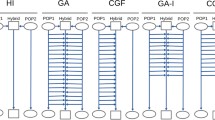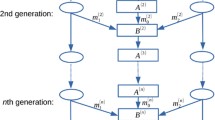Abstract
Modeling linkage disequilibria (LD) between genes usually observed in admixed natural populations has been shown an effective approach in high-resolution mapping of disease genes in humans. A prerequisite to obtain accurate estimation of recombination fraction between genes at a marker locus and the disease locus using the approach is a reliable prediction of the proportion of the admixture populations. The present study suggested the use of gene frequencies to predict the estimate of the admixture proportion based on the observation that the gene frequencies are much more stable quantities than the haplotype frequencies over evolution of the population. In this paper, we advanced the theory and methods by which the decay rate of nonlinear term of LD in admixed population may be used to estimate the recombination fraction between the genes. Theoretical analysis and simulation study indicate that, the larger the difference of gene frequencies between parental populations and the more closely the admixture proportion approaches 0.5, the more important the nonlinear term of the LD in the admixed population, and hence the more informative such admixed populations in the high-resolution gene mapping practice.
Similar content being viewed by others
References
Luo, Z. W., Zhang, R. M., Theoretical strategies for high-resolution mapping of complex genetic disorders in humans, Chinese Chinese Science Bulletin, 1999, 44: 193.
Stephens, J. C., Briscoe, D., O’Brien, S. J., Mapping by admixture linkage disequilibrium in human populations: limits and guidelines, Am. J. Hum. Genet., 1994, 55: 809.
Graham, J., Thompson, E. A., Disequilibrium likelihoods for fine-scale mapping of a rare allele, Am. J. Hum. Genet., 1998, 63: 1517.
Boehnke, M., Limits of resolution of genetic linkage studies: implications for the positional cloning of human disease genes, Am. J. Hum. Genet., 1994, 55: 379.
Briscoe, D., Stephens, J. C., O’ Brien, S. J., Linkage disequilibrium in admixed population: Application in gene mapping, The Journal of Heredity, 1994, 85(1): 59.
Risch, N., Merikangas, K., The future of genetic studies of complex human diseases, Science, 1996, 273: 1516.
Chakraborty, R., Weiss, K. M., Admixture as a tool for finding linked genes and detecting that difference from allelic association between loci, Proc. Natl. Acad. Sci. USA, 1988, 85: 9119.
McKeigue, P. M., Mapping genes underlying ethnic differences in disease risk by linkage disequilibrium in recently admixed populations, Am. J. Hum. Genet., 1997, 60: 188.
McKeigue, P. M., Mapping genes that underlie ethnic differences in disease risk: Methods for detecting linkage in admixed populations by conditioning on parental admixture, Am. J. Hum. Genet., 1998, 63: 241.
Jorde, L. B., Watkins, W. S., Kere, J. et al., Gene mapping in isolated populations: new roles for old friends? Hum. Hered., 2000, 50: 57.
Kaplan, N. L., Hill, W. G., Weir, B. S., Likelihood methods for locating disease genes in nonequilibrium populations, Am. J. Hum. Genet., 1995, 56: 18.
Terwilliger, J. D., A powerful likelihood method for the analysis of linkage disequilibrium between trait loci and one or more polymorphic marker loci, Am. J. Hum. Genet., 1995, 49: 31.
Devlin, B., Risch, N., A comparison of disequilibrium measures for fine-scale mapping, Genomics, 1995, 29: 311.
Lazzeroni, L. C., Linkage disequilibrium and gene mapping: an empirical least-squares approach, Am. J. Hum. Genet., 1998, 62: 159.
Service, S. K., Lang, D. W., Freimer, N. B. et al., Linkage-disequilibrium mapping of disease genes by reconstruction of ancestral haplotypes in founder populations, Am. J. Hum. Genet., 1999, 64: 1728.
Tao, S. H., Zhang, R. M., Chu, J. H. et al., A population genetics model of linkage disequilibrium in admixed population, Chinese Science Bulletin, 2001, 46 (3): 193
Chakraborty, R., Smouse, P. E., Recombination of haplotypes leads to biased estimates of admixture proportion in human populations, Proc. Natl. Acad. Sci. USA, 1988, 85: 3071.
Luo, Z. W., Detecting linkage disequilibrium between a polymorphic marker locus and a trait locus in natural population, Heredity, 1998, 80: 198.
Weir, B. S., Cockerham, C. C., Estimation of linkage disequilibrium in randomly mating populations, Heredity, 1979, 42(1): 105.
Author information
Authors and Affiliations
Corresponding author
About this article
Cite this article
Tao, S., Liu, X., Chu, J. et al. Rate of decay in admixture linkage disequilibrium and its implication in gene mapping. Chin.Sci.Bull. 46, 358–363 (2001). https://doi.org/10.1007/BF03183263
Received:
Issue Date:
DOI: https://doi.org/10.1007/BF03183263




